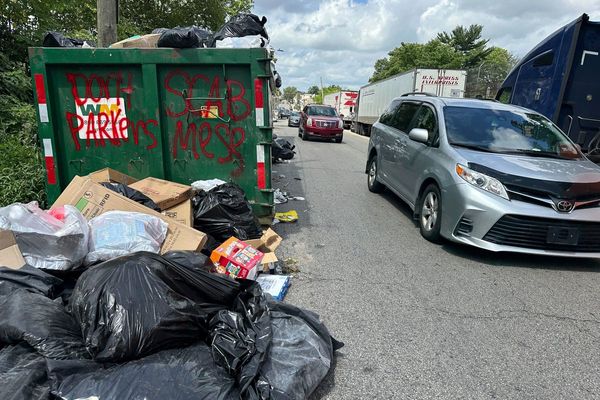
When Nina Collins thinks of her mother, Kathleen, she remembers the sound of a typewriter: “an IBM on a rickety old table”, the sight of the yellow notepads on which she wrote in longhand, the view of the Hudson river from her mother’s bedroom window. “She was always writing,” she tells me.
Yet were it not for Nina, Kathleen Collins, a pioneering African American film director, playwright, civil rights activist and educator, would today be unknown – or no more than an obscure footnote in an academic paper. It was the release of the film Losing Ground, written and directed by Kathleen in 1982, at a film festival at the Lincoln Center in Manhattan in 2015 that brought her triumphantly into focus (the film was never publicly screened in Kathleen’s lifetime). And it was Nina who found the distributor, Milestone Films, and at her own expense ($25,000) had the film remastered – a loving gesture to her mother, but one she assumed would have little impact.
The film is a revelation. Confident, untidy – in the way real life is – and haunting, it is a portrait of a black intellectual: a beautiful, aloof professor (Seret Scott) and her artist husband (Bill Gunn), whose charming smile does not blind his wife to his philandering. Celia, the pretty Puerto Rican model (Maritza Rivera) he takes up with, turns the marriage into a tense triangle. The film explores, in a way that recalls DH Lawrence, the struggle of being a woman in love, the tug between art and life, the anger that underscores such conflicts. Richard Brody, in the New Yorker, greeted it as a “nearly lost masterwork”, adding: “Had it been screened widely in its time, it would have marked film history.” When Nina read his review, she wept: “It was very wonderful but strange that my mother could have no idea of this excitement – the film went on to play in art-house cinemas all over the country.”
Now it is being followed by the publication of Whatever Happened to Interracial Love?, a collection of her mother’s stories, chosen by Nina.
But we begin by talking about Kathleen’s death, aged 46, in 1988. Nina lives in New York: she worked for years as a literary agent but for a long time could not face her mother’s legacy. “When my mother died, I had just turned 19. My parents had divorced when I was little. My brother, Emilio, was 15. My mother married my stepfather a year before she died.”
Nina was studying German in Vienna when her mother rang her: “You need to come home. I’m fine, but the breast cancer I had before has come back.” She had never told Nina about the cancer: “She had kept this awful secret. It was such a shock.”
Two weeks later, Kathleen died. Her only instruction to Nina was: “I want you to become Emilio’s legal guardian.” Neither her father nor her stepfather were – Nina chooses her words carefully – “quite engaged” enough for the responsibility. “And so I did it… but it was hard.”
Why does she think her mother kept the cancer secret? She tells me she has been working on a memoir, off and on, for 10 years to try to answer that question. “I reached a point where I realised much of my adult pain and sadness came from that betrayal,” she says. “It was such a bad decision on her part. She was a believer in alternative medicine – a new age person, she treated herself homeopathically. I think she must have been in denial. When the cancer came back, she was excited I was out in the world and perhaps did not want to affect that. But then again, when I asked my stepfather, years later, he said that she did not want to deal with other people’s grief.”
Nina’s memoir will be entitled Forgive Me If I Disappear – partly suggested by her mother’s appearance: “She was beautiful, with caramel-coloured skin, delicate hands and feet. She was hippy-dippy… wore leotards, was ethereal.” But the title is also a line from one of her mother’s letters. “It sums up the feeling of my childhood. She was there and loved us, but was not able to be present. She was an artist before a mother.”
At 47, Nina is a year older than her mother was when she died, which she finds a “liberation”. She is starting to understand – and forgive: “She was depressed when I was little, yet also vibrant and funny. People imply ours was a bad relationship – I don’t feel that way. But it was a lonely childhood.”
After her death, Nina put her mother’s papers in a trunk that travelled around with her, but it was not until she had gone through a divorce herself that she decided to open Kathleen’s box (she describes the process in an interview in Vogue). She found a 700-page unfinished novel, two movies, six or seven plays, half a dozen screenplays, letters, a journal and short stories. An admirer of the film, Brigid Hughes, editor of literary journal A Public Space, contacted her in the autumn of 2015. She was producing an issue on forgotten female artists. Did Nina have any unpublished writing by her mother? “Getting never published stories by a dead black woman published would have been impossible without the film,” she says.
One particularly absorbing story, The Happy Family, subjects domestic harmony to scrutiny. It makes one wonder: was Kathleen’s original family happy? “It was a strict, conservative upbringing, a sad household. Her mother died when Kathleen was a baby – of pneumonia. Her sister, Francine, was epileptic. Her father had a terrible temper – as did she. He remarried a sweet, God-fearing but not super-intellectual woman who lived in her husband’s shadow.”
In 1963, Kathleen graduated in philosophy and religion from Skidmore, a liberal arts college in New York state, and, in 1966, went to Paris to study at the Sorbonne (her stories are garnished with French words). It was in Paris that she fell in love with Nina’s father. He was white, “super-intellectual”, a Berkeley maths graduate who had done “all sorts of interesting jobs – working on the railroads in Berlin and opera sets in Italy. It was he who turned her on to the surrealists.” And it was he who got Kathleen interested in film (which she studied in Paris). “My father made a short experimental film set on the floor of the New York stock exchange. And together they made – but did not star in – porn films, when I was little, to raise money for their projects.”
Back in the US, after a stint teaching French, Kathleen got a job as a film editor, and by 1974 was teaching film at City College, New York. Ronald Gray, one of her students, became a cinematographer and suggested they make a narrative film together – the start of Losing Ground.
What is remarkable in the stories, I say, is the openness with which she writes about sex. Was she like this in life? “She was straightforward and funny. But when I first had sex and told her, she was mortified. She also had a prim side.”
In what is perhaps the most startling story she writes about confounding expectations by being more refined than the white man she is with – until the end, when she hesitates about climbing into a four-poster bed: “How could I pass beneath the candelabras and undress? Tastefully enough. And make love? Tastefully enough. No coloured woman could…”
However much reflections on race underline her fiction, it was “not something she talked about at home, or something we felt traumatised by. I never felt complicated about race.” What is amazing, Nina maintains, is her mother’s ability to introduce readers to new characters – to black intellectuals you have never seen before on the screen or on the page.
I suggest to Nina that the stories – written when Kathleen was in her 20s – are, more than anything, about sorrow. Why was this? “She was an artist, a depressive person, and her relationship with my father was horrible: it features in all the stories and is the basis for Losing Ground.”
There is a particularly striking story, Interiors, about abandonment and solitude, a portrait of a woman who grows herbs, makes collages and remembers a violin consumed by fire. In another story, she writes: “I was still young enough to be attracted to sorrow.” Nina cherishes her mother’s etching, which reads: “For once in my life, I won’t let sorrow hurt me.” It is, she laughs, a line from a Stevie Wonder song. And Nina chose an arresting, if anguished, line for the book’s opening page: “It is easy to do evil things, easy to harm oneself. To do what is good for oneself is very difficult.” Looking at the second half of that quotation now, it seems to offer itself as a clue to Kathleen and Nina’s story – although Nina is inconclusive, still wrestling with the question: where does she end? Where do I begin?
• Whatever Happened to Interracial Love? by Kathleen Collins is published by Granta (£12.99). To order a copy for £9.74 go to bookshop.theguardian.com or call 0330 333 6846. Free UK p&p over £10, online orders only. Phone orders min p&p of £1.99 Waterstones at Tottenham Court Road, London hosts Whatever Happened to Interracial Love?, a discussion about the stories, and screening of Losing Ground, by Kathleen Collins, on 10 February at 6.30pm







